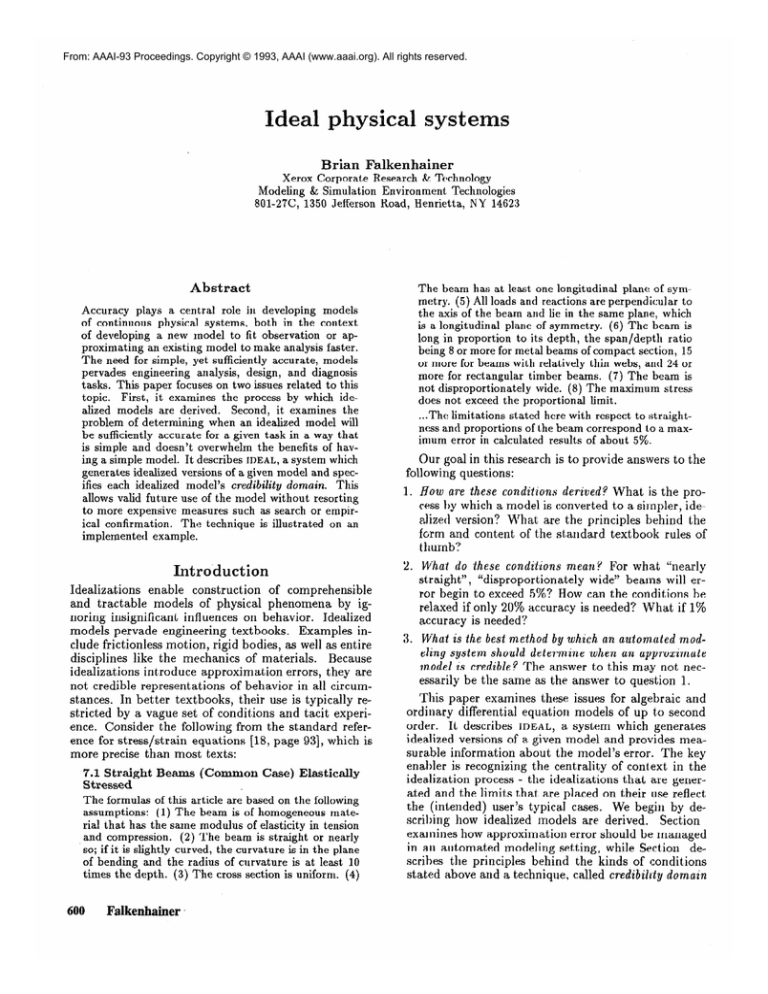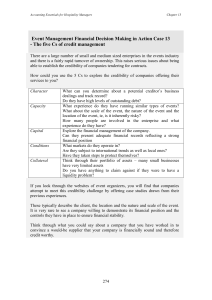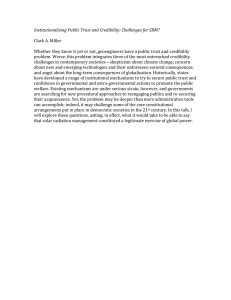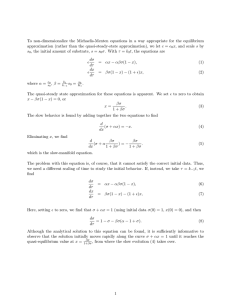
From: AAAI-93 Proceedings. Copyright © 1993, AAAI (www.aaai.org). All rights reserved.
Ideal
Brian Falkenhainer
Xerox Corporate
Research & Technology
Modeling & Simulation
Environment
Technologies
801-27C, 1350 Jefferson Road, Henrietta, NY 14623
Abstract
Accuracy
plays a central role in developing
models
of continuous
physical systems,
both in the context
of developing
a new model to fit observation
or approximating
an existing model to make analysis faster.
The need for simple, yet sufficiently
accurate, models
pervades engineering
analysis, design, and diagnosis
tasks. This paper focuses on two issues related to this
topic.
First, it examines
the process by which idealized models are derived.
Second,
it examines
the
problem of determining
when an idealized model will
be sufficiently
accurate for a given task in a way that
is simple and doesn’t overwhelm
the benefits of having a simple model. It describes IDEAL, a system which
generates idealized versions of a given model and specifies each idealized
model’s
crecld’bo’laty domcss’n. This
allows valid future use of the model without resorting
to more expensive measures such as search or empirical confirmation.
The
technique
is illustrated
on an
implemented example.
Introduction
Idealizations
enable
construction
of
comprehensible
and tractable
models of physical phenomena
by ignoring insignificant
influences on behavior.
Idealized
models pervade engineering
textbooks.
Examples include frictionless motion, rigid bodies, as well as entire
disciplines
like the mechanics
of materials.
Because
idealizations
int,roduce approximation
errors, they are
not credible representations
of behavior in all circumstances. In better textbooks,
their use is typically restricted by a vague set of condit,ions and tacit experience. Consider the following from the standard
reference for stress/strain
equations
[18, page 931, which is
more precise than most texts:
7.1 Straight Beams (Common
Stressed
Case) Elastically
The formulas
of this article
assumptions:
(1) The beam is of homogeneous mate-
are based on the following
rial that has the same modulus of elasticity in tension
and compression.
(2) The beam is straight or nearly
so; if it is slightly curved, the curvature is in the plane
of bending and the radius of curvature is at least 10
times the depth. (3)Th e cross section is uniform.
(4)
600
Falkenhainer
The beam has at least one longitudinal
plane of symmetry. (5)All loads and reactions are perpendicular
to
the axis of the beam and lie in the same plane, which
is a longitudinal
plane of symmetry.
(6)The beam is
long in proportion
to its depth, the span/depth
ratio
being 8 or more for metal beams of compact section, 15
or more for beams with relatively thin webs, and 24 or
(7) The beam is
more for rectangular
timber beams.
not disproportionately
wide. (8)The maximum stress
does not exceed the proportional
limit.
. ..The limitations stated here with respect to straightness and proportions
of the beam correspond to a max-
imum error in calculated results of about 5%.
Our goal in this research
following questions:
is to provide
answers
to the
How are these conditions
derived? What is the process by which a model is converted to a simpler, idealized version ? What are the principles behind the
form and content of the standard
textbook rules of
thumb?
What do these conditions
mean?
For what “nearly
straight”,
“disproportionately
wide” beams will error begin to exceed 50/o? Bow can the conditions be
relaxed if only 20% accuracy is needed? What if 1%
accuracy is needed?
What is the best method by which an autom.uted modeling system should determine
when an approximate
model is credible?
Tile answer to this may not nec-
essarily
be the same as the answer
to question
1.
This paper examines these issues for algebraic and
ordinary differential equation models of up t’o second
order. It describes IDEAL,
a system which generates
idealized versions of a given model and provides measurable information
about the model’s error. The key
enabler is recognizing the centrality
of context in the
idealization
process - the idealizations
that are gener-
ated and the limits that are placed on their use reflect
the (intended)
user’s typical cases. We begin by describing how idealized models are derived.
Section
exainines how approximation
error should be rnanaged
in an automated
modeling
setting,
scribes the principles behind
stated above and a technique,
while Section
de-
the kinds of conditions
called credibidlty domain
synthesis,
for generating
them. It closes with a discussion of how the same functionality
might be achieved
for more complex systems. In particular,
our ultimate
goal is to be able to reproduce the above passage, which
requires the analysis of 3-dimensional,
4th-order partial differential equations.
Idealizations
A model M contains
a set of (algebraic
and ordinary differential)
equations
E describing
the behavior of some physical system in terms of variables V =
{t, ~2,. . . , yk-l,~~,.
. . ,pn], where gi represents
a dependent variable, and pi represents
a constant, model
parameter
(i.e., pa is a function of elements external to
the model).’
At most one varying independent
variable t is allowed (which typically denotes time). Each
model also has an associated
set of logical preconditions, as described in [6]. We make the simplification
that all analyses occur in a single operating region (i.e.,
the status of the preconditions
does nob change and
thus can be ignored for the purposes of this paper).
A behavior is a vector v = [VI, . . . , un] of assignments
to V as a function of t over the interval t E [0, t/3. A
set of boundary conditions B specify values for tf , the
model parameters,
and yi (0) for all y; such that B and
M uniquely
specify a behavior v = BEHAVIOR(M,B).
An idealized model M” arises from bhe detection
of order of magnitude
relationships,
such as those deof negscribed in [lo; 71, which enable the elimination
This can produce significant
simplifiligible terms.
cations by reducing simultaneities
and nonlinearities,
and enabling
closed-form,
analytic solutions.
In t!his
paper, we consider the use of the two most common
idealization
assumptions:
DOMINANCE-REDUCTION:
ISO-REDUCTION:
A
9--
+
T
B
M
= 0
A
given
given
+
IAl >> IBI
X0
D
Dominance-reduction
ignores negligible influences on a
quantity and is the basis for idealizations
like frictionless motion. When applied to derivative pairs, it offers
one approach to time-scale approximation:
TIME-SCALE-REDUCTION:
$$f
=
0
given
1+$I
B
I $$I
Iso-reduction
assumes constancy
and is the basis for
idealizations
like quasi-statics,
homogeneous
materials,
and orthogonal
geometries.
It is often the key enabler
to obtaining
analytic solutions.
In general, order of magnitude
reasoning requires a
carefully designed set of inference rules (e.g., approximate equality is not transitive
[lo]).
For the class
of ODES currently being studied, algebraic operations
across a set of equations are unnecessary
and these issues do not arise. Thus, IDEAL currently uses only the
‘This is also kno wn as an esogenozcs variable in the economics and AI literature.
Throughout, we will try to use
standard engineering terminology and indicate synonyms.
two idealization
rules without the associated machinery t#o propagate their consequences.2
Given that M” is an idealization
of M, the error
function e of M” ‘s approximate
behavior V* is measured with respect to M’s predicted behavior v and
couched in an appropriate
scalar norm e = 11V* - v 11,
the standard
rneasure of goodness of an approximation [3]. The results are independent
of the particular
norm. Jn the examples we will use the maximum (L,)
norm for the relative error
ea(vi)
=
max 1
WO,-tf1
2$(t) - q(t)
vi(t)
where e= [el, . . . , e,] and ei is the error norm for variable vi. At times (section ), the instantaneous
error
value as a function of t will be used in place of the
absolute value norm.
A model is credible with respect to error tolerance
-T = [Ta,..., Q] if ea (vi) 5 ri for every variable vi for
which a tolerance has been specified. Not all variables
need have an associated tolerance;
the error of these
variables is unmonitored
and unconstrained.
The cr.&
ibilily domain of an idealized model is the range of
model parameters
and t for which t,he simplified model
is a credible representation
of the original model [2].
Idealization process
A model may be idealized in at least two settings.
In
the on-demand
setting, idealizations
are made during
the course of using a model to analyze a specific system. In the compilation
setting, a model is idealized
into a set of simpler models a priori by assuming the
different potential relationships
that enable use of the
idealization
rules.
Because much of the on-demand
setting is a special case of the compilation
setting, we
will focus solely on the latter. The key then is tdpreidentify the set of enabling relationships
that might
arise. One straw-man
approach would be to systematically explore all algebraic combinations
and assume
hypothetical
situations in which the idealizations’ conditions would hold.
For example, for every pattern
A + 8, we could make one reduction
based on A >> B
and another based on A < B (when consistent
with
the given equations).
To make &efv/ idealizations,
we
must have informat.ion
about what relationships
are
possible or likely in practice.
This is critical both in
guiding the idealization
process and in characterizing
each idealized model’s credibility domain (as discussed
in section ).
The more specific the information
about what is
likely, the more the idealized models may be tuned for
one’s specific future needs. Information
about the population of analytic tasks is represented
as a set of distributions
over parameter
values across problems and
their variability
within each problem (see Table 1).
‘The current implementation is in Mathematics, which
is a hindrance to implementing the kinds of order of magnitude systems described in [lo; 71.
Reasoning about Physical Systems
601
Table 1: Some distributions
typical problem set.
lhstrlbutlon
characterizing
of parameter
an analyst’s
values
p E [0.1..1.5]
uniform, normal, truncated
Independent
Joint (e.g., A mav never be small when B is large)
Simple Ranges
L)dmbutlon
I
Constant
Nearly
Constant
of functron types
1
%Y= 0
&
dz
_- =O
Y = Yb:), 121 > 0
Dependent
dv
z
Mgfd:
= ag + af +
Gruvity:
Distributions
on parameter
values indicate which inequalities are likely or possible. They provide information about the population
of tasks as a whole. Parameters specified by simple ranges are treated as having
uniform distributions
over their range.
Distributions
on function types provide information
about the pertask behavior
of parameters.
For example, material
densities may have wide variance across different analyses, but are normally
constant
throughout
the material during any single analysis.
These distributions
are currently given as input; in the context of a CAD
environment,
they could easily be obtained by saving
information
about each analytic session.
IDEAL is guided by two factors - the form of the
original equations
and the problems to which they are
typically applied.
Given a model and associated
distributions,
it proceeds as follows:3
1. Syntactically
identify
candidates
Based on the two reduction
rules,
ther a sum or a derivative.
for reduction.
a candidate
is ei-
2. For sums, cluster the addenda into all possible dominant/negligible
equivalence
classes based on the
given distributions.
Each parameter’s
possible range
is truncated
at three standard
deviations
(otherwise
it could be infinite and lead to spurious order of magnitude relationships).
3. For each possible reduction
rule application,
an idealized
model under the assumption
rule’s applicability
condition.
derive
of the
4. Repeat for consistent
combinations
of idealization
assumptions
(c-f., assumption
combination
in an
ATMS
[4]).
.
,!%&ng Fricts’on:
Ah- Resistance:
Example (sliding motion)
Figure 1 illustrates
the
problem of determining
the velocity and position of a
block as it slides down an incline.
The given model
considers the influences of gravity, sliding friction, and
air resistance.
Due to the nonlinear
response to air
resistance,
the model has no analytic solution.*
The
3This is a more complete
version of the algorithm
described in [13]. F or example, the earlier algorithm did not
consider the ISO-REDUCTION
rule.
4Well 7 at least not one that Mathematics
can find.
Falkenhainer
ai7 = g sin 0
af = -pkg cos &gn( v)
ad = -Cdp,irL
2v2sgn(v)/2M
lhstrlbutlons
1 parameter
I
i!
type
truncated
(t E
*
Pk
dv
jg
dt
pdf
normal
-
1
e Lz
2. 4.52
[0..00])
uniform
[30°..600]
truncated,
skewed
(,!& E [0.2..0.55])
dependent
-’
Pk - CL;i- 2.54
8
dependent
Figure 1: A block slides down an inclined plane. Need
we model sliding friction, air drag, or both?
In the
table, pdf = probability &f&y
function
methods apply to higher-dimensions,
but to enable 3dimensional
visualization
and simplify the presentation, the initial velocity, ~0 = 0, and the air resistance
coefficient ( CdPair L2) will be treated as constants.
IDEAL
begins by identifying
patterns
for which the
idealization
rules may apply. In this case, there is the
single sum
ag + Uf + Ud
The assumption
of IAl > ]Uj is limited by requiring
that at least IA/B] 2 10 must be possible. Using this
constraint
and the given distributions,
only one partial
ordering is possible: Iag + a~ 1 >> 1a,l/. This enables, vi a
dominance-reduction,
the derivation of a simple linear
approximation
M,J :
e
602
ad
;li-=v
- A,f
= ag +“f,
fro:1 which we can derive
v(t) = A,f t, x:(t) = *t2
usserrnhg
A,f
>> ad
da: dl-v
+ 2(J
(J&f)
Had the distributions
covered wider ranges for angle
and time, and allowed air resistance to vary, a space
of possible models, each with its own assumptions
and
credibility
domain, would be derived.
For example,
high viscosity, long duration,
and low friction would
make the friction term insignificant
with respect to the
drag terns, resulting in another idealized model:
-dv
= g sin 0 - Cdpaa., L”v”sgn(v)/2M
dt
cbssetming Agd >> af
rror management
for automated
modeling
The idealized model M,f derived in the example offers
a considerable
computational
savings over its more detailed counterpart.
Unfortunately,
it is also quite nonoperational
as stated.
What does A,f > ad mean?
When should one expect 5%, lo%, or 50% error from
the model?
What we would like is a mechanism
for
bounding
the model’s error that is (1) easy to compute at problem solving time - it should require much
less time than the time savings gained by making the
idealization,
and (2) reliable - failure, and subsequent
search for a more accurate model, should be the exception rather than the rule.
One appealing
approach lay in the kinds of thresholds illustrated
in the introduction,
but augmented
with some clarifying quantitative
information.
However, it is not as simple as deriving e as a function of
Asf/ad
or sampling
different values for A,f /ad and
computing
the corresponding
error.
For a specified
error threshold
of 5%, the meaning of A,J > ad is
strongly influenced by the model parameters
and the
independent
variable’s interval. Figure 2 illustrates the
error in position as a function of A,f = ag + af and
time t. The problem is further compounded
in the context of differential equations.
Not only does ad change
with time, the influence of error accumulation
as time
progresses can dominate that of the simple A,J > ad
relationship.
Second, much of the requisite information cannot be obtained
analytically
(e.g., e(A,f, t)).
For each value of A,J and TV, we must numerically
integrate out to tf. Thus, any mechanism
for a ptiorz
bounding
the model’s error presupposes
a solution to
a difficult, N-dimensional
error analysis problem.
The key lies in the following observation:
only an
approximate
view of the error’s behavior
is needed
- unlike
the original
approximation,
this “metaapproximation”
need not be very accurate.
For example, a 5% error estimate that is potentially
off by 20%
means that the error may actually be only as much
as 6%. This enables the use of the following simple
procedure:
1. Sample
butions
the error’s behavior over the specified
to obtain a set of datapoints.
dist,ri-
2. Derive an approximate
equation for each ea as a function of the independent
variable and model parameters by fit,ting a polynomial
to the N-dimensional
surface of dat apoints.
If the error is moderately
smooth, this will provide a
very reliable estimate of the model’s error.5 For M,! ‘s
5As one reviewer correctly noted, global polynomial
approximations
are sensitive to poles in the function
being
modeled.
For the general case, a more reliable method is
Figure 2: Percentage error in position z over the ranges
for A,f = a, + af and time t produced by M,f-
error in position rt: (shown in Figure
approximating
polynomial
is
2), the resulting
ex = 3.52524lo-" +2.20497 1O-6 Agf - 3.18142lo-" Air
-4.02174 1O-7 Aif - 0.00001793972
-0.0000191978Agf t- 1.201021O-6 A2 t
j-3.684321O-6 t2 -0.0000940654 Agf t9
+2.83115 1O-8 A’gp t2 - 1.14351O-7 t3
At this point, the specified requirements
(easy to compute and reliable) have bot,h been satisfied, without
generating
explicit thresholds!
Although not, as comprehensible,
from an automated
modeling perspective
this approximate error equation is preferable because it
provides two additional
highly desirable features:
(3)
a continuous
estimate of error that is better able to
respond to differing accuracy requirements
than a simple binary threshold,
and (4) coverage of the entire
problem distribution
space by avoiding the rectangular discretization
imposed by thresholds on individual
dimensions.
Credibility
domain
synthesis
The question still remains - where do conditions
like
“the bearn is not disproportionately
wide” come from
and what do they mean ? They are clearly useful in
providing intuitive, qualitative indications of a model’s
credibility
domain.
Further,
for more complex systems, increased dimensionality
may render the derivation of an explicit error function infeasible.
The basic
goal is to identify bounds in the independent
variable
and model parameters
that specify a region within the
model’s credibility domain for a given error tolerance.
This is the credibzlity domain synthesis problem:
find
tf cd
oIt<tf
p,, p: for every pn E P such that
A [v(piEP),p;ip,<pf]
-+
t?<T
needed, such as local interpolation
or regression on a more
phenomena-specific
basis function.
There is nothing in the
IDEAL algorithm which limits use of these methods.
easoning about Physical Systems
603
-6
A,f
-8
Figure 3: The error function imposes conservation
on the shape of the credibility domain.
laws
the error are omitted. Why? How is that (likely to be)
sound? Consider the conditions synthesized
for M,f .
The limits for p and 0 cover their entire distribution;
they are irrelevant with respect to the anticipated
analytic tasks and may be omitted.6 Only the independent
variable’s threshold imposes a real limit with respect
to its distribution
in practice.
Like the textbook
conditions,
credibility
domain
synthesis makes one assumpt,ion about the error’s behavior - it must not exceed T inside the bounding
region. This is guaranteed
if it is unimodal and concave
between thresholds,
or, if convex, strictly decreasing
from the threshold.
M,f
satisfies the former condition. However, the current implementation
lacks the
ability to construct such proofs, beyond simply checking the derived datapoints.
Related
Unfortunately,
these dimensions are interdependent.
Increasing
the allowable interval for pa decreases the
corresponding
interval for pj. Figure-3 illustrates
for
subject
to
a
5%
error
threshold.
A
credibility
dow7.f
main that maximizes the latitude for t also minimizes
What criteria should be used to
the latitude for A,f.
determine the shape of the hyperrectangle?
Intuitively,
the shape should be the one that maximizes the idealized model’s expected future utility.
We currently
define future utility as its prior probability.
Other influences on utility, when available, can be easily added
These include the cost of obtainto this definition.
ing a value for pi and the likely measurement
error
Given distributions
on parameter
values and
of pi.
domain synthesis problem
derivatives,
the credibility
as the following optimizacan be precisely formulated
tion problem:
minimize
F(tf,P~,P~,...,p,,P~)
=
l-P(ost<tft
subject
Pk <Pk
<Pzy...yP,
<Pn
<P$)
to e 5 7
For the case of M,f and the distributions
Figure 1, the optimaicredibility
domain is
t < 8.35
A
pk > 0.2
A
0 < 60’
which has a prior probability
of 0.975.
This formulation
has several beautiful
1. The credibility domain is circumscribed
easily computed conditions.
properties:
by clear and
2. It maximizes the idealized model’s future
cording to the user’s typical needs.
3. It offers a precise explanation
derlying the standard
textbook
given in
-
utility
of the principles
rules of thumb.
acun-
asIn particular,
it explains some very interesting
For
pects of the passage quoted in the introduction.
example, a careful examination
of the theory of elasticity-[14], f rom which the passage’s corresponding
formulas were derived, shows that several influences on
604
Falkenhainer
Work
Our stance, starting with [13], has been that the traditional AI paradigm of search is both unnecessary
and
inappropriate
for automated
modeling because experienced engineers rarely search, typically selecting the
appropriate
model first. The key research question is
then to identify the tacit knowledge such an engineer
possesses.
[5] explores the use of experiential
knowledge at the level of individual
cases.
By observing
over the course of time a model’s credibility in differextrupolaent parts of its parameter
space, credibility
tion can predict the model’s credibility
as it is applied
to new problems.
This paper adopts a generalization
stance - computationally
analyze the error’s behavior a
priori and then summarize it with an easy to compute
mechanism for evaluating model credibility.
This is in contrast to much of the work on automated
management
of approximations.
In the graph of models approach [L], the task is to find the model whose
predictions are sufficiently close to a given observation.
Search begins with the simplest model, moves to a new
model when prediction fails to match observation,
and
is guided by rules stating each approximation’s
qualitative effect on the model’s predicted behavior. Weld’s
dornain-independent
formulation
[15] uses the same basic architecture.
Weld’s derivation
and use of bounding abstractions
[16] has the potential
to reduce this
search significantly
and shows great promise. Like our
work, it attempts
to determine
when an approximation produces sound inferences.
One exception to the
search paradigm is Nayak [9], who performs a postanalysis validation for a system of algebraic equations
using a mix of the accurate and approximate
models. While promising,
it’s soundness
proof currently
rests on overly-optimistic
assumptions
about the error’s propagation
through the system.
“This occurred because p and 61 were bound by fixed
intervals, while t had the oo tail of a normal distribution,
which offers little probabilistic gain beyond 2-3 standard
deviations.
Credibility
domain synthesis most closely resembles
methods for tolerance synthesis (e.g., [S]), which also
typically use an optimization
formulation.
There, the
objective function maximizes the allowable design tolerances subject to the design performance
constraints.
ntriguing
PI Falkenhainer,
B. Modeling without amnesia:
Making
experience-sanctioned
approximations.
In The Sixth
EdInternational
Workshop
on Qualitative
Reasoning,
inburgh, August 1992.
VI Falkenhainer,
B and Forbus, K. D.
Compositional
Armodeling:
F’m d ing the right model for the job.
51(1-3):95-143,
October
1991.
tificial Intelligence,
questions
Credibility
domain synthesis suggests a model of the
principles
behind the form and content of the standard textbook rules of thumb. Their abstract, qualitative conditions,
while seemingly vague, provide useful,
general guidelines by identifying
the important
landmarks.
Their exact values may then be ascertained
with respect to the individual’s
personal typical probThis “typical” set of problems
lem solving context.
can be characterized
by distributions
on a model’s parameters which in turn can be used to automatically
provide simplified models that are specialized to particular needs.
The least satisfying
element is the rather bruteforce way *in which the error function
is obtained.
While it only takes a few seconds on the described
examples,
they are relatively
simple examples
(several permutations
of the sliding block example
described here and the more complex fluid flow / heat
exchanger example described in [S]). The approach will
likely be intractable
for higher-dimensional
systems
over wider distributions,
particularly
the Z-dimensional
PDE beam deflection problem.
How else might the
requisite information
be acquired?
What is needed to
reduce sampling
is a more qualitative
picture of the
error’s behavior.
This suggests a number of possible
future directions.
One approach would be to analyze
the phase space of the system to identify critical points
and obtain a qualitative
picture of its asymptotic
behavior, which can in turn suggest where to measure
one could use qualitative
[ll; 12; 171. Alt ernatively,
envisioning
techniques
to map out the error’s behavior. The uncertainty
with that approach lies in the
possibility
of excessive ambiguity.
For some systems,
traditional
functional
approximation
techniques might
be used to represent the error’s behavior.
Acknowledgments
PI
Mavrovouniotis,
M and Stephanopoulos,
G. Reasoning
with orders of magnitude
and approximate
relations.
In Proceedings
of the Sixth National
Conference
on Artificial Intelligence,
pages 626-630,
Seattle, WA, July
1987. Morgan Kaufmann.
PI
Michael, W and Siddall, J. N. The optimization
problem with optimal tolerance assignment and full acceptance. Journal of Mechanical
Design, 103:842-848,
October 1981.
PI
Nayak, P. P.
Validating
approximate
equilibrium
models.
In Proceedings
of the AAAI-91
Workshop
on Model-Based
Reasoning, Anaheim,
CA, July 1991.
AAAI Press.
PI
Raiman, 0.
InteEligence,
Order
of magnitude
reasoning.
1991.
Artificial
51(1-3):11-38,
October
P 11Sacks,
E. Automatic
qualitative
analysis of dynamic
systems using piecewise linear approximations.
Art+&al Intelligence,
41(3):3
13-364,1989/90.
P21 Sacks,
E. Automatic
analysis of one-parameter
planar
ordinary differential equations by intelligent numerical
simulation.
Artificial
Intelligence,
48( 1):27-. 56, February 1991.
PI
Shirley, M and Falkenhainer,
B.
Explicit
reasoning
about accuracy
for approximating
physical systems.
In Working Notes of the Automatic
Generation
of Approximations
and Abstrcactions
Workshop,
July 1990.
[W
Timoshenko,
S.
New York, 1934.
Th eory of Elasticity.
McGraw-Hill,
P51 Weld,
D. Approximation
reformulations.
In Proceedings of the Eighth National
Conference
on Artificial
Intelligence,
Boston, MA, July 1990. AAAI Press.
WI
W’eld. D. S. Reasoning about model accuracy.
Art+
c&l Intelligence,
56(2-3):255-300,
August 19!12.
WI
Yip, K. M.-K.
Understanding
complex
visual and symbolic
reasoning.
Artificial
5l( l-3):179-221,
October
1991.
PI
Young, W. C. Road’s
Formulas
for Stress & Strain,
Sixth Edition.
McGraw-Hill,
New York, NY, 1989.
dynamics
by
Intelligence,
Discussions
with Cohn Williams,
both on the techniques and on programming
Mathematics,
were very
valuable.
References
[I] Addanki,
S, Cremonini,
Graphs of models.
ArtificiaZ
177, October
1991.
[2] Brayton,
R. K and Spruce,
R,
and Penberthy,
J. S.
Intelligence,
51(l-3):145-
R.
miaation. Elsevier, ,Imsterdam,
Sensitivity
1980.
and
Opli-
N. Numerical
[3] Dahlquist,
G, BJ‘or&, A, and Anderson,
Methods.
Prentice-Hall,
Inc, New Jersey, 1974.
[4] de Kleer, J. An assumption-based
Intelligence,
28(a), March 1986.
TMS.
Artificial
easoning about Physical Systems
605








